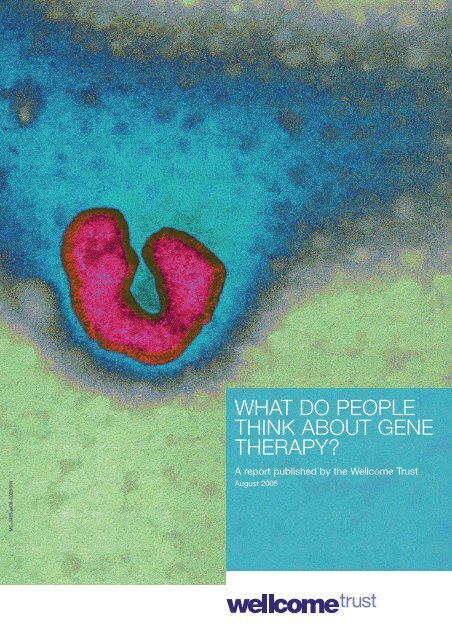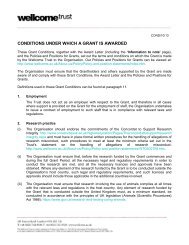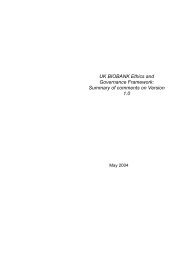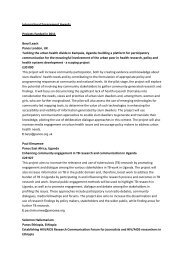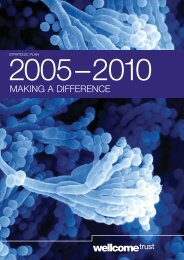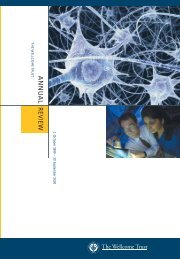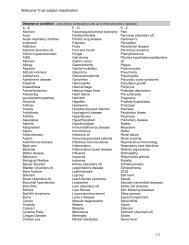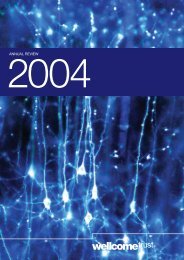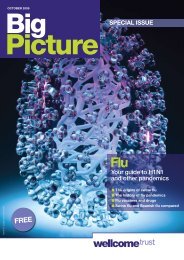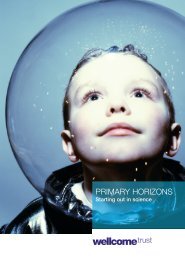what do people think about gene therapy? - Wellcome Trust
what do people think about gene therapy? - Wellcome Trust
what do people think about gene therapy? - Wellcome Trust
You also want an ePaper? Increase the reach of your titles
YUMPU automatically turns print PDFs into web optimized ePapers that Google loves.
MC-3465.p/08–2005/SW<br />
WHAT DO PEOPLE<br />
THINK ABOUT GENE<br />
THERAPY?<br />
A report published by the <strong>Wellcome</strong> <strong>Trust</strong><br />
August 2005
What <strong>do</strong> People Think <strong>about</strong> Gene Therapy?<br />
<strong>Wellcome</strong> <strong>Trust</strong><br />
Gibbs Building<br />
215 Euston Road<br />
Lon<strong>do</strong>n NW1 2BE<br />
T +44 (0)20 7611 8888<br />
F +44 (0)20 7611 8545<br />
E contact@wellcome.ac.uk<br />
www.wellcome.ac.uk<br />
A report published by the <strong>Wellcome</strong> <strong>Trust</strong><br />
The <strong>Wellcome</strong> <strong>Trust</strong> is an independent researchfunding<br />
charity, established under the will of Sir Henry<br />
<strong>Wellcome</strong> in 1936. It is funded from a private<br />
en<strong>do</strong>wment, which is managed with long-term stability<br />
and growth in mind. Its mission is to foster and<br />
promote research with the aim of improving human<br />
and animal health.<br />
The <strong>Wellcome</strong> <strong>Trust</strong> is a registered charity, no.<br />
210183. Its sole <strong>Trust</strong>ee is The <strong>Wellcome</strong> <strong>Trust</strong><br />
Limited, a company registered in England, no.<br />
2711000, whose registered office is 215 Euston<br />
Road, Lon<strong>do</strong>n NW1 2BE.<br />
Cover image: Colour-enhanced image of the<br />
Sendai virus. It is being investigated as a vector for<br />
<strong>gene</strong> <strong>therapy</strong> in diseases such as cystic fibrosis.<br />
University of Edinburgh<br />
August 2005<br />
1
1. Introduction<br />
New biomedical technologies are usually complex and unfamiliar, especially<br />
when they have not yet been developed for widespread use. This is definitely<br />
the case with <strong>gene</strong> <strong>therapy</strong>, which has made it difficult to get a clear idea of<br />
<strong>what</strong> public attitudes to altering human <strong>gene</strong>s might be. In 1999, the National<br />
Centre for Social Research (NatCen) began a major study for the <strong>Wellcome</strong><br />
<strong>Trust</strong> that set a new benchmark for understanding <strong>what</strong> <strong>people</strong> in the UK<br />
thought <strong>about</strong> <strong>gene</strong> <strong>therapy</strong>, and how their attitudes were formed.<br />
The research was primarily concerned with building upon existing models of<br />
social research to develop more rigorous models of public consultation. It<br />
assessed the impact of innovative stimuli intended to encourage and support<br />
debate <strong>about</strong> the social and ethical issues raised by scientific developments.<br />
By combining both quantitative and qualitative approaches in a panel study, it<br />
attempted to offer both breadth and depth of understanding in relation to<br />
public attitudes towards <strong>gene</strong> <strong>therapy</strong>.<br />
The study began with a detailed survey of opinion. It then moved on to a<br />
series of follow-up inquiries designed to shed light on <strong>what</strong> kind of information<br />
or process may affect attitudes. That is, it went beyond survey metho<strong>do</strong>logy to<br />
provide <strong>people</strong> with more information, and allowed participants to discuss a<br />
range of different possible uses of <strong>gene</strong>tic techniques.<br />
This summary report presents some of the findings of the study. As the results<br />
of the initial survey are a few years old now, it also compares them with some<br />
less detailed surveys that have been conducted in the UK, the USA and<br />
Australia. The fact that those are broadly in line with the more elaborate study<br />
carried out by NatCen suggests that their results remain important to take into<br />
account in discussion of the development and regulation of <strong>gene</strong> <strong>therapy</strong>. The<br />
report then gives some details of the later stages of the study, and of <strong>what</strong><br />
was found <strong>about</strong> the effects of providing additional information and discussion<br />
of the issues.<br />
2. The stages of the study<br />
The face-to-face baseline survey was conducted between October and<br />
December 1999. Those who agreed to take part were then asked to<br />
participate in follow-up telephone interviews at several points over the course<br />
of the study. These were: to see if they had read a special magazine sent to<br />
them <strong>about</strong> <strong>gene</strong> <strong>therapy</strong> (the Genie), and with <strong>what</strong> effect; to assess the<br />
results of day-long discursive workshops; and to see if their attitudes were the<br />
same some months later. These results were compared with key questions<br />
placed on the quarterly national omnibus survey conducted by the Office for<br />
National Statistics (ONS).<br />
2
The full plan for the study is set out in figure 1 below.<br />
Figure 1: Timing of study stages<br />
Oct.–Dec. 1999<br />
Stage 1: face-to-face survey<br />
Dec. 1999 Mailout of the Genie magazine<br />
Dec.–Jan. 2000<br />
Stage 2: telephone survey<br />
Feb.–Mar. 2000 22 local group events<br />
Mar. 2000 Video sent to group non-attenders<br />
Mar.–Apr. 2000<br />
Stage 3: telephone survey<br />
May–Jun. 2000 Qualitative follow-up with<br />
group non-attenders<br />
Sep. 2000<br />
Stage 4: telephone survey<br />
ONS omnibus<br />
monitoring<br />
survey (Nov.)<br />
ONS omnibus<br />
monitoring<br />
survey (Mar.)<br />
ONS omnibus<br />
monitoring<br />
survey (Sep.)<br />
3
The numbers of participants reduced between each stage, and the<br />
composition of the sample also changed. So the results from each stage are<br />
not directly comparable. Nevertheless, they <strong>do</strong> give some useful indication of<br />
the effects of the additional information and discussion on participants’<br />
attitudes.<br />
3. Key findings<br />
Some key findings of the initial survey were:<br />
• Public attitudes towards <strong>gene</strong> <strong>therapy</strong> were complex. The initial survey<br />
used several carefully developed scenarios, concerning somatic,<br />
germline and in utero therapies and possible applications: lifethreatening<br />
conditions, those regarded as non-medical, and<br />
improvements (scenarios included heart disease, cystic fibrosis,<br />
baldness and boosting memory in healthy subjects).<br />
• Attitudes towards the acceptability of altering <strong>gene</strong>s varied a great deal<br />
from one scenario to another. The research showed that <strong>people</strong> <strong>do</strong><br />
make distinctions between medical and non-medical applications, and<br />
between somatic, germline and in utero <strong>gene</strong> <strong>therapy</strong>. While the<br />
majority are comfortable with the idea of somatic <strong>therapy</strong> for serious<br />
illness (for instance, 82% would allow somatic <strong>gene</strong> <strong>therapy</strong> to treat<br />
heart disease), only two-thirds (64%) would support germline <strong>therapy</strong><br />
for this, and in utero <strong>therapy</strong> commanded even less support (49%).<br />
• Awareness of and knowledge <strong>about</strong> <strong>gene</strong> <strong>therapy</strong> were both fairly low.<br />
• Few participants knew anything <strong>about</strong> the existing regulatory system:<br />
15% of the sample were aware that the UK permits experiments<br />
altering <strong>gene</strong>s in somatic but not reproductive cells.<br />
• Most participants were found to be optimistic <strong>about</strong> progress in <strong>gene</strong><br />
<strong>therapy</strong> research. Seven out of ten believed that <strong>gene</strong> <strong>therapy</strong> could<br />
already treat some or many diseases and six in ten <strong>think</strong> that <strong>gene</strong><br />
<strong>therapy</strong> treatments for heart disease will exist within five to ten years.<br />
Subsequent stages of the study found that:<br />
• Reading the <strong>gene</strong> <strong>therapy</strong> magazine had little effect on attitudes,<br />
although it appeared to increase both knowledge and reassurance<br />
<strong>about</strong> the existing regulatory framework.<br />
• More participants watched the video than read the magazine, but with<br />
similar effects on attitudes.<br />
• The most powerful effects on attitudes stemmed from the combined<br />
video and extended group discussions. After these events, the smaller<br />
number of <strong>people</strong> involved demonstrated: more knowledge of<br />
4
egulations and trust in their adequacy; more trust in scientists; and<br />
more enthusiasm <strong>about</strong> <strong>gene</strong>tic research in <strong>gene</strong>ral and fewer <strong>do</strong>ubts<br />
<strong>about</strong> its future uses. However, they also showed reduced support for<br />
<strong>gene</strong> <strong>therapy</strong> for non-medical reasons.<br />
• The final follow-up interview showed that these more powerful changes<br />
in this smaller group were lasting. Attitudes among the <strong>gene</strong>ral<br />
population, as measured by the ONS omnibus survey, remained<br />
broadly unchanged.<br />
4. Knowledge, interest and outlook<br />
Before looking at <strong>what</strong> <strong>people</strong> thought <strong>about</strong> altering <strong>gene</strong>s, it is useful to<br />
know a little <strong>about</strong> their <strong>gene</strong>ral interest in and attitudes towards <strong>gene</strong>tics.<br />
These survey results are based on face-to-face interviews with a<br />
representative sample of just under 700 adults across the UK in late 1999. As<br />
other surveys have found, most had heard of <strong>gene</strong>tically modified foods and<br />
cloning, but awareness of <strong>gene</strong> <strong>therapy</strong> was quite a bit lower. Asked if they<br />
had heard <strong>about</strong> “curing diseases through <strong>gene</strong>tics” within the last month,<br />
only 41% said yes. This figure fell to 31% among readers of tabloid<br />
newspapers, but stood at 64% for broadsheet readers. In line with this, most<br />
<strong>people</strong> (79 %) reported that they received little or no information <strong>about</strong><br />
<strong>gene</strong>tics. Nor was <strong>gene</strong>tics in <strong>gene</strong>ral a topic of conversation. About half of<br />
the sample had not discussed it with anyone else in the past year. A simple<br />
<strong>gene</strong>tic knowledge quiz suggested that most <strong>people</strong> had a little basic<br />
knowledge of <strong>gene</strong>tic facts, but more often resorted to ‘<strong>do</strong>n’t know’ when<br />
asked more detailed questions. See table 1 below for more details.<br />
5
Table 1: The <strong>gene</strong>tic knowledge quiz<br />
Percentage giving each answer (correct answers in bold)<br />
Statement True False Don’t<br />
know<br />
Identical twins have the same <strong>gene</strong>s 65 17 18<br />
Whether a couple have a boy or a girl<br />
depends on the woman’s <strong>gene</strong>s<br />
Half your <strong>gene</strong>s come from your mother<br />
and half from your father<br />
15 64 21<br />
61 19 20<br />
Down’s syndrome is an inherited disease 22 58 20<br />
Children look like their parents because<br />
they have the same type of red blood cells<br />
Most cells in our body contain a copy of all<br />
our <strong>gene</strong>s<br />
There are test tube babies who grew<br />
entirely outside the mother’s body<br />
Genes of all living things on earth are made<br />
up of different combinations of only 4 or 5<br />
chemical building blocks<br />
We have around 150 000 different<br />
chromosomes, which contain our <strong>gene</strong>s<br />
15 58 26<br />
57 7 36<br />
31 47 23<br />
28 12 61<br />
31 13 56<br />
Not surprisingly, then, beliefs <strong>about</strong> the current state of <strong>gene</strong> <strong>therapy</strong> tended<br />
to be inaccurate. More than half of the sample (60%) thought that some<br />
diseases could already be treated by altering <strong>gene</strong>s. There is little evidence<br />
that this is the case today (2005) and there was certainly none in 1999. Some<br />
<strong>people</strong> (8%) already believed that many diseases were treatable.<br />
The survey also probed <strong>people</strong>’s <strong>gene</strong>ral attitudes towards science. The<br />
results again show an encouraging consistency with other studies. Most<br />
<strong>people</strong> (79%) agreed that science makes our lives healthier, easier and more<br />
comfortable, but half still felt that it makes things change too fast – a feeling<br />
more prevalent among older interviewees. Those aged over 55 were also<br />
twice as likely as younger <strong>people</strong> to <strong>think</strong> that modern science <strong>do</strong>es more<br />
harm than good, with more than 20% agreeing with this statement.<br />
5. Gene <strong>therapy</strong>: in <strong>gene</strong>ral<br />
In addition to considering the acceptability of <strong>gene</strong> <strong>therapy</strong> in a range of<br />
different circumstances, respondents were also asked a set of <strong>gene</strong>ral<br />
questions <strong>about</strong> <strong>gene</strong>tic research and <strong>gene</strong> <strong>therapy</strong>. Their answers at this<br />
level already indicate some ambivalence <strong>about</strong> the idea of altering <strong>gene</strong>s. A<br />
large majority thought that <strong>gene</strong>tic treatments could reduce human suffering,<br />
and that research would <strong>do</strong> more good than harm. However, just as many<br />
<strong>people</strong> also agreed with the suggestion that it would be better to cure illness<br />
in other ways. And more than a quarter felt that we should never interfere with<br />
6
<strong>people</strong>’s <strong>gene</strong>s, and it would be better not to find out how to <strong>do</strong> it (see table 2<br />
below).<br />
Table 2: Attitudes to <strong>gene</strong>tic research and treatments<br />
Percentage agreeing with each statement<br />
Positive:<br />
Genetic treatments for illness will <strong>do</strong> a lot to reduce human suffering 76<br />
In the end, research into human <strong>gene</strong>s will <strong>do</strong> more to help us than to harm us 68<br />
People worry too much <strong>about</strong> the risks of changing human <strong>gene</strong>s 43<br />
Negative:<br />
It is better to try to cure illness without changing <strong>people</strong>’s <strong>gene</strong>s 74<br />
Changing a person’s <strong>gene</strong>s is too risky, <strong>what</strong>ever the benefits might be 49<br />
We should never interfere with <strong>people</strong>’s <strong>gene</strong>s 31<br />
It would be better if we did not know how to change <strong>people</strong>’s <strong>gene</strong>s at all 28<br />
Changing <strong>gene</strong>s should be forbidden as it is tampering with nature 26<br />
Scientists should not look for <strong>gene</strong>tic cures, because the world will become too<br />
overpopulated<br />
How <strong>do</strong>es this translate into responses to specific proposals for altering<br />
<strong>gene</strong>s?<br />
6. Gene <strong>therapy</strong>: where and when?<br />
Most previous attempts to find out <strong>what</strong> <strong>people</strong> <strong>think</strong> <strong>about</strong> altering human<br />
<strong>gene</strong>s stopped at <strong>gene</strong>ral questions, and did not elucidate <strong>what</strong> was meant by<br />
<strong>gene</strong> <strong>therapy</strong>. An important feature of this survey was that it was more<br />
detailed in approach. After the first set of questions, the interviewers moved<br />
on to inquiries <strong>about</strong> a collection of carefully worded scenarios in which<br />
<strong>gene</strong>tic alteration might play a part. They were designed to bring out a<br />
number of differences between potential uses of new <strong>gene</strong>tic technology.<br />
For example, <strong>gene</strong>s might be altered in somatic (body) cells, to help a single<br />
individual who already has a disease, or is at risk of getting it. Or <strong>gene</strong>s might<br />
be changed in reproductive cells (germline <strong>therapy</strong>), in a way which would be<br />
passed on to someone’s children. Many countries already distinguish between<br />
these two categories of <strong>gene</strong> <strong>therapy</strong> in their regulations. A third category was<br />
also included here: altering fetal <strong>gene</strong>s in the womb (in utero <strong>therapy</strong>). See<br />
box 1 below for example questions.<br />
Aside from which cells are targeted, and when, the possible applications also<br />
vary. The researchers wanted to distinguish between life-threatening<br />
conditions, those normally regarded as non-medical, and actual<br />
improvements. Specifically, they asked <strong>about</strong> heart disease, the <strong>gene</strong>tic<br />
20<br />
7
disease cystic fibrosis, baldness, and the possibility of improving memory in<br />
healthy subjects.<br />
Box 1: Sample questions <strong>about</strong> types of <strong>gene</strong> <strong>therapy</strong><br />
Somatic<br />
Germline<br />
In utero<br />
Heart disease can happen when a person’s arteries get clogged up<br />
and not enough blood gets to the heart. This can cause pain and<br />
disability and may lead to a heart attack. Eating healthier food, not<br />
smoking, and taking regular exercise can reduce the risk of getting<br />
heart disease. People with heart disease may need to take drugs or<br />
have major surgery.<br />
I’d like you to <strong>think</strong> of someone in their 20s who has serious heart<br />
disease. Suppose it was discovered that changing some of their<br />
<strong>gene</strong>s by giving them an injection could help treat their heart disease.<br />
These new <strong>gene</strong>s would not be passed onto any children they might<br />
later have.<br />
Do you <strong>think</strong> this should be allowed or not allowed?<br />
Now, <strong>what</strong> if the new <strong>gene</strong>s were passed onto their future children, to<br />
give them less chance of getting serious heart disease in their 20s?<br />
Do you <strong>think</strong> this should be allowed or not allowed?<br />
Now suppose a person’s <strong>gene</strong>s could be changed before they were<br />
born – by treatment while still in their mother’s womb – to give them<br />
less chance of getting serious heart disease in their 20s. The new<br />
<strong>gene</strong>s would not be passed onto any children they later have. Do you<br />
<strong>think</strong> this should be allowed or not allowed?<br />
The results were intriguingly varied. When the target condition was a serious<br />
illness and only body cells were affected, the vast majority would agree to<br />
<strong>gene</strong>tic alteration: 92% for cystic fibrosis and 82% for heart disease. A twothirds<br />
majority (63%) would even allow changing <strong>gene</strong>s to overcome<br />
baldness. But far fewer – only 34% – would approve of this approach to<br />
improving memory.<br />
If the change was proposed to affect reproductive cells, so that the person’s<br />
children would be spared disease, keep their hair or have better memories,<br />
approval fell. But three-quarters of the sample still felt that this would be<br />
acceptable for cystic fibrosis, and just under two-thirds for heart disease. In<br />
each case, altering <strong>gene</strong>s in the womb was the least acceptable option. The<br />
idea of operating on unborn babies clearly increased any <strong>do</strong>ubts <strong>people</strong><br />
already had <strong>about</strong> <strong>gene</strong>tic procedures.<br />
8
Figure 2: Approval rates for <strong>gene</strong> <strong>therapy</strong> applications<br />
Percentage support for use of different types of <strong>gene</strong> <strong>therapy</strong> for different conditions<br />
%<br />
100<br />
80<br />
60<br />
40<br />
20<br />
0<br />
Cystic fibrosis Heart disease Baldness Memory<br />
7. Complex attitudes confirmed<br />
Somatic<br />
Germ-line<br />
In utero<br />
This picture of attitudes to different types of <strong>gene</strong> <strong>therapy</strong> is partly confirmed<br />
by other surveys carried out since 1999 in Britain and elsewhere. All show<br />
strong support for the idea of <strong>gene</strong> alteration – even germline alteration – to<br />
prevent or cure disease. At the same time, there is <strong>gene</strong>ral wariness <strong>about</strong><br />
the possibility of <strong>gene</strong> alteration for non-medical use.<br />
In the UK, for example, a national MORI survey in 2000 commissioned by the<br />
medical charity Action Research found that “74% of the public agrees that<br />
<strong>gene</strong> <strong>therapy</strong> is acceptable if tightly controlled”. A later MORI poll for the<br />
Medical Research Council, in 2003, indicated that 40% of <strong>people</strong> thought that<br />
the applications of DNA knowledge of most benefit to society were <strong>gene</strong><br />
<strong>therapy</strong> and the ability to understand and predict inherited diseases. And a<br />
qualitative study in Wales in 2002 found significant support for germline<br />
<strong>therapy</strong> for cystic fibrosis 1 .<br />
The latest major UK survey of knowledge <strong>about</strong> and attitudes towards<br />
<strong>gene</strong>tics was carried out between June and September 2003 as part of a<br />
large-scale Economic and Social Research Council-funded study. The study<br />
also included extensive follow-up work using interviews, focus groups and<br />
other methods, but only the basic survey results have been published to date.<br />
This national survey of 3500 <strong>people</strong> involved <strong>gene</strong> <strong>therapy</strong> questions on the<br />
annual British Social Attitudes Survey – run by the National Centre for Social<br />
Research (NatCen) – some of which had been used in previous rounds of that<br />
1 See, respectively: www.mori.com/polls/2000/action.shtml;<br />
www.mori.com/polls/2003/mrc.shtml; and Iredale R, Dolan G, McDonald K, Kirk M. Public<br />
attitudes to human <strong>gene</strong> <strong>therapy</strong>: a pilot study in Wales. Community Genetics<br />
2003;6(3):139–46.<br />
9
survey, allowing an assessment of the extent to which attitudes are changing<br />
over time. It found that 81% thought that <strong>gene</strong>tic alteration should “definitely<br />
or probably be allowed” to reduce someone’s chances of getting breast<br />
cancer. More than half were also willing to permit it to make someone less<br />
aggressive or violent. The percentages were much lower for making someone<br />
heterosexual rather than homosexual (18%) or determining the sex of an<br />
unborn baby (15%). Very similar responses to this question were recorded in<br />
1998 and 2000, although the percentage approving of the idea of <strong>gene</strong><br />
alteration to help prevent breast cancer rose from 72% in both of those years<br />
to the 81% figure of 2003 2 .<br />
Other surveys from abroad yield more similarities to the findings from the<br />
NatCen study. A nationwide telephone survey in the USA in 2002 for the<br />
Genetics and Public Policy Centre at Johns Hopkins University found that<br />
opinions <strong>about</strong> <strong>gene</strong>tic engineering to avoid disease and to create desirable<br />
traits almost mirrored one another. Disease avoidance prompted 59%<br />
approval and 34% disapproval. Use of <strong>gene</strong>tic techniques to promote<br />
desirable traits such as strength, intelligence or attractiveness, on the other<br />
hand, was disapproved of by 76% of this sample, and approved by only 20% 3 .<br />
Like the detailed British survey, this study also found that knowledge of <strong>gene</strong><br />
<strong>therapy</strong> was pretty sketchy, with 23% of <strong>people</strong> believing that it was already<br />
possible to prevent a <strong>gene</strong>tic disease using <strong>gene</strong>tic engineering. And, again<br />
as in the UK, approval for efforts to deal with disease extended to germline<br />
alteration. In fact that 59% approval figure was in response to the question:<br />
would you approve or disapprove if parents were offered a way to change<br />
their own <strong>gene</strong>s in order to prevent their children from having a <strong>gene</strong>tic<br />
disease?<br />
Finally, a nationwide survey of attitudes to biotechnology in Australia in 2003,<br />
the latest in a series, found that 71% believed that <strong>gene</strong> <strong>therapy</strong> would<br />
“improve our way of life” 4 . And, similar to the UK figure, 21% of <strong>people</strong> in the<br />
USA believed that <strong>gene</strong> <strong>therapy</strong> was already <strong>do</strong>ing so. Another 24% thought it<br />
would bring improvements within five years, and 28% in 10 years. If this<br />
indicates some kind of approval, then one must also take into account that<br />
33% of those asked thought that <strong>gene</strong> <strong>therapy</strong> was already making things<br />
worse.<br />
Those Australian findings seem harder to interpret than answers to questions<br />
that probe approval directly. But taken together, these later surveys suggest<br />
that the results of the NatCen study are a snapshot of public opinion in Britain<br />
that has not been superseded, and that is broadly similar to results in other<br />
2<br />
For details, see Park A, Curtice J, Thomson K et al (eds). British Social Attitudes: The 21st<br />
report. Lon<strong>do</strong>n: Sage; 2004.<br />
3<br />
Genetics and Public Policy Center, Johns Hopkins University. 2002. Attitudes <strong>about</strong><br />
Reproductive Genetics. See www.dnapolicy.org/research/reproductiveGenetics.jhtml.<br />
4<br />
Millward Brown Australia, for Biotechnology Australia. 2003. Biotechnology Public<br />
Awareness Survey: Final report. See www.biotechnology.gov.au/index.cfm?event=object.<br />
showContent&objectID=F76C3B54-BCD6-81AC-165EA28AFE8D57AD.<br />
10
countries. It also appears that this study remains the best one conducted so<br />
far for those who want an in-depth look at attitudes and factors that affect<br />
them.<br />
8. What influences attitudes to <strong>gene</strong> <strong>therapy</strong>?<br />
The detailed results of the survey conducted by NatCen can be analysed to<br />
give some indications <strong>about</strong> the sorts of personal characteristic that may<br />
affect <strong>people</strong>’s views of <strong>gene</strong> <strong>therapy</strong>. Both education, and knowledge of<br />
<strong>gene</strong> <strong>therapy</strong>, for example, seemed to have some effect. Some other studies<br />
have indicated that knowing more <strong>about</strong> it may make <strong>people</strong> more likely to<br />
support <strong>gene</strong> <strong>therapy</strong>. The results here suggested that it is not as simple as<br />
that. For instance, while knowing more <strong>about</strong> <strong>gene</strong>tics went along with higher<br />
approval of somatic <strong>gene</strong> <strong>therapy</strong> for serious illnesses such as cystic fibrosis,<br />
the more knowledgeable were some<strong>what</strong> less likely to support germline<br />
alteration.<br />
Attitudes to science in <strong>gene</strong>ral also mattered. People who had a <strong>gene</strong>rally<br />
optimistic view of science as a force for good were more likely to <strong>think</strong> that<br />
<strong>gene</strong> <strong>therapy</strong> was acceptable. However, this was not true across the board;<br />
optimists <strong>about</strong> science were less likely than others to like the idea of memory<br />
enhancement through <strong>gene</strong>tic alteration.<br />
A number of other factors were linked to attitudes to <strong>gene</strong> <strong>therapy</strong>. These<br />
included age, <strong>gene</strong>tic interest, trust in science and scientists, and religion.<br />
Unlike some earlier surveys, the study picked up rather little in the way of<br />
differences between men and women.<br />
The survey also found a close relationship between views <strong>about</strong> <strong>gene</strong> <strong>therapy</strong><br />
and attitudes towards abortion, with those who are most opposed to abortion<br />
also being opposed to <strong>gene</strong> <strong>therapy</strong>. The researchers suggest that this is<br />
because both may be seen as interfering with natural processes. The<br />
researchers explored the extent to which in utero <strong>gene</strong> <strong>therapy</strong> might be<br />
considered as preferable to abortion in relation to an unborn child being<br />
confirmed to have cystic fibrosis. Despite the <strong>gene</strong>ral lack of support for <strong>gene</strong><br />
<strong>therapy</strong> in utero, most <strong>people</strong> (66%) still thought this would be preferable to<br />
abortion of the affected fetus.<br />
Based on analysis of the data from the qualitative workshops, a number of<br />
factors were found to influence judgements <strong>about</strong> the acceptability of <strong>gene</strong><br />
<strong>therapy</strong>. Overall, attitudes were underpinned by concerns relating to potential<br />
risks and consequences arising from the use of <strong>gene</strong> <strong>therapy</strong>.<br />
Participants rationalised that the risks of <strong>gene</strong> <strong>therapy</strong> were worth taking in<br />
circumstances where they judged the condition to be serious, potentially lifethreatening,<br />
or where the quality of life was felt to be very poor. In these<br />
cases, panel members sometimes even overcame their opposition to germline<br />
and in utero <strong>gene</strong> <strong>therapy</strong>, arguing that the associated risks were worth taking<br />
if it would prevent serious medical conditions being passed on, or developing.<br />
11
For example, in utero <strong>gene</strong> <strong>therapy</strong> was sometimes positively viewed as an<br />
option for children who would be born with Down’s syndrome, autism, alphathalassemia<br />
or cystic fibrosis. Where, however, participants did not perceive<br />
the case to be serious enough to risk the treatment – as, for example, in other<br />
medical applications and for cosmetic enhancements – they displayed their<br />
opposition to the use of any type of <strong>gene</strong> <strong>therapy</strong>.<br />
Judgements were also dependent upon the degree of impact that <strong>gene</strong><br />
<strong>therapy</strong> was likely to have on a particular condition. It was argued that the<br />
risks of <strong>gene</strong> <strong>therapy</strong> were worth taking if there was a real chance that it could<br />
bring relief and prevent the deterioration of a particular condition. In<br />
circumstances, however, where it was perceived that the treatment was likely<br />
to be of limited benefit because a condition had already progressed too far, for<br />
example following a heart attack, then it was sometimes argued that there<br />
would be little value in employing <strong>gene</strong> <strong>therapy</strong>.<br />
While the consequences of the treatment influenced judgements <strong>about</strong> all<br />
applications of <strong>gene</strong> <strong>therapy</strong>, there was greater opposition where it was felt<br />
that there might be longer-term consequences, such as problems later in life<br />
or a mutation further <strong>do</strong>wn the germ line. Equally, the use of in utero <strong>therapy</strong><br />
was opposed on the grounds that it was ‘tampering with a fetus’ during the<br />
developmental process and, as a consequence, might result in longer-term<br />
consequences for the child and its mother.<br />
The nature of alternative treatments available sometimes had a bearing on<br />
judgements <strong>about</strong> somatic <strong>gene</strong> <strong>therapy</strong>. It seemed that <strong>gene</strong> <strong>therapy</strong> was<br />
more acceptable and worth risking in circumstances where there was<br />
perceived to be no existing treatment available. Equally, it was viewed more<br />
positively in circumstances where alternative treatments were perceived to be<br />
risky, to have a lower success rate, or to have debilitating side-effects (as in<br />
the case of chemo<strong>therapy</strong>). Conversely, where the alternative treatments<br />
were viewed as effective and relatively free of side-effects (such as<br />
counselling, psycho<strong>therapy</strong> and antidepressants for depression, or hair<br />
transplants or wigs for baldness), <strong>gene</strong> <strong>therapy</strong> was judged to be<br />
unacceptable.<br />
The age of the patient sometimes seemed to affect judgements <strong>about</strong> <strong>gene</strong><br />
<strong>therapy</strong>. In some cases it was argued that a high priority should be placed on<br />
using <strong>gene</strong> <strong>therapy</strong> to treat or prevent a serious medical condition in children<br />
and young <strong>people</strong>. In these circumstances, it seemed that the risks were<br />
sometimes worth taking because young <strong>people</strong> were at the beginning of their<br />
lives and therefore had more to lose. This view, however, did not seem to<br />
extend to in utero <strong>therapy</strong> – although there was insufficient opportunity within<br />
the workshops to explore this further.<br />
The accuracy of the screening tests in predicting whether someone would<br />
develop a particular condition also affected whether respondents believed it<br />
was acceptable to use <strong>gene</strong> <strong>therapy</strong> or not. Given the concerns <strong>about</strong> the<br />
potential risks and consequences of <strong>gene</strong> <strong>therapy</strong>, there was less ease <strong>about</strong><br />
12
its use in cases where there was some <strong>do</strong>ubt <strong>about</strong> whether a particular<br />
condition would develop.<br />
The cost of the treatment was another factor that influenced judgements. The<br />
potential drain on NHS resources was raised primarily in connection with the<br />
use of <strong>gene</strong> <strong>therapy</strong> for non-medical applications. Thus, where <strong>people</strong> judged<br />
cosmetic enhancements as acceptable, they sometimes qualified this by<br />
stressing it should not be available on the NHS.<br />
9. Attitudes to regulation<br />
Agreeing that <strong>gene</strong> <strong>therapy</strong> might be acceptable <strong>do</strong>es not indicate<br />
unconditional approval for all potential applications. There was a wide range<br />
of hopes and fears <strong>about</strong> <strong>what</strong> discoveries in <strong>gene</strong>tics might bring, and<br />
although the hope <strong>gene</strong>rally outweighed the concern, many <strong>people</strong> (41%)<br />
reported having a mixture of the two. When it came to specifics, there were<br />
many worries, ranging from unethical experiments, side-effects and risks, to<br />
more diffuse concerns <strong>about</strong> ‘playing God’ or creating a ‘master race’.<br />
Not surprisingly, then, there were some strong views <strong>about</strong> who should be<br />
involved in regulation. Most thought the Government needed to be involved,<br />
but it was commonly felt that <strong>do</strong>ctors and patients should have a say too.<br />
Scientists and researchers were also thought to have a role to play. However,<br />
there were two groups whom half or more did not want involved in the<br />
regulation of <strong>gene</strong> <strong>therapy</strong>: pharma companies and religious groups.<br />
Interestingly, religious <strong>people</strong> were more likely than others to believe that<br />
existing regulations were inadequate, a tendency shared by the more highly<br />
educated.<br />
At the same time, most <strong>people</strong> actually knew little <strong>about</strong> how <strong>gene</strong> <strong>therapy</strong> is<br />
regulated now. Only 15% knew that the UK currently permits experiments<br />
altering <strong>gene</strong>s in somatic but not reproductive cells. Such a low awareness of<br />
the existing regime, combined with a <strong>gene</strong>ral disinclination to trust<br />
government and a wariness <strong>about</strong> some of the possibilities of <strong>gene</strong> <strong>therapy</strong>,<br />
suggests that this will be a difficult area for politicians and regulators to<br />
manage. It also invites the question of how best to improve <strong>people</strong>’s<br />
knowledge of the issues, and <strong>what</strong> effect this might have on their attitudes.<br />
10. Does more information change attitudes?<br />
Finding out more <strong>about</strong> a new and potentially controversial subject is one<br />
factor among many that may influence a person’s attitudes. Moreover, it is an<br />
open question as to how knowledge might influence the views <strong>people</strong> hold.<br />
The later stages of this study give some indication of <strong>what</strong> can happen in the<br />
case of <strong>gene</strong> <strong>therapy</strong>. As indicated in Section 3, both the specially prepared<br />
magazine and the video had some effect on knowledge for those prepared to<br />
read or watch, but the data show little effect on attitudes that can be attributed<br />
solely to the new information. One exception here was that participants<br />
13
ecame better informed <strong>about</strong> the regulatory system. There was also a small<br />
shift towards trusting scientists to regulate themselves and not to conceal<br />
details of their work.<br />
A more potent influence on attitudes (albeit for a smaller number of<br />
participants) was the extended group discussions. The information input here<br />
is difficult to specify because one of the things that those who took part were<br />
most enthusiastic <strong>about</strong> was the chance to talk to other <strong>people</strong> and hear their<br />
opinions and arguments. The effect here is due to the whole experience of the<br />
day, perhaps, rather than any particular part of it.<br />
The group participants certainly felt that they became better informed. They<br />
reported knowing more <strong>about</strong>:<br />
• how <strong>gene</strong> <strong>therapy</strong> works and <strong>what</strong> it might achieve<br />
• the difference between somatic and germline <strong>therapy</strong><br />
• the different applications of <strong>gene</strong> <strong>therapy</strong> – medical and non-medical<br />
• the regulation and control of <strong>gene</strong> <strong>therapy</strong><br />
• how far <strong>gene</strong> <strong>therapy</strong> has progressed.<br />
Some also said that their participation might mean they would take a<br />
more active interest in the coverage of <strong>gene</strong> <strong>therapy</strong> in the future.<br />
This increase in knowledge and awareness did go along with some shifts in<br />
attitude. Event participants became more enthusiastic <strong>about</strong> <strong>gene</strong>tic research<br />
in <strong>gene</strong>ral and less worried <strong>about</strong> its potential applications.<br />
Those who attended the group events became more positive <strong>about</strong> the use of<br />
<strong>gene</strong> <strong>therapy</strong> to treat disease. A more positive attitude specifically among<br />
those who had participated in the group event can be seen in their responses<br />
to certain questions. They showed an increase of 12 percentage points in the<br />
proportion agreeing with the statement ‘<strong>gene</strong> <strong>therapy</strong> will reduce human<br />
suffering’, and an 11-point decrease in those agreeing that ‘it is better to cure<br />
illness without changing human <strong>gene</strong>s’. Agreement that ‘we worry too much<br />
<strong>about</strong> the risks’ increased by 13 points and there was a 12-point increase in<br />
disagreement that ‘we should forbid <strong>gene</strong> changes as this is tampering with<br />
nature’.<br />
Those who had attended the group event demonstrated a 26-point increase in<br />
knowledge that somatic <strong>gene</strong> <strong>therapy</strong> is allowed but germline <strong>therapy</strong> is not,<br />
from 14% to 40%. Opinions <strong>about</strong> who should influence decisions on <strong>gene</strong><br />
<strong>therapy</strong> regulation also changed, suggesting that participation in a group<br />
event had shifted participants towards wanting influence spread more evenly<br />
between the various interest groups, rather than be <strong>do</strong>minated by scientists<br />
and the medical profession.<br />
After attending the events and watching the video, participants did seem more<br />
reassured <strong>about</strong> the regulation of <strong>gene</strong> <strong>therapy</strong>. There was an 11-point<br />
increase in agreement that ‘the rules are strict enough to protect us from<br />
associated dangers’.<br />
14
This theme of reassurance is also evident when asked how far scientists<br />
should be trusted to regulate themselves. During the second interview, a<br />
majority of participants were in favour of restricting <strong>gene</strong>tic research to that<br />
which is clearly related to detecting, preventing and curing disease. However,<br />
only those who attended a group event became more willing to trust scientists<br />
to <strong>do</strong> <strong>what</strong>ever research they choose (an increase of 19 points. Another<br />
indication that trust had increased is that the <strong>people</strong> who had attended the<br />
group event and those who had only seen the video both became less likely<br />
to believe that some <strong>gene</strong>tic discoveries were being kept secret to avoid<br />
public outcry (a decrease of 10 and 9 percentage points respectively).<br />
However, they became less likely to approve of germline <strong>gene</strong> <strong>therapy</strong>, even<br />
for serious medical conditions such as heart disease, and appreciably less<br />
supportive of any kind of <strong>gene</strong> <strong>therapy</strong> for non-medical reasons, such as<br />
baldness or for memory enhancement.<br />
15


